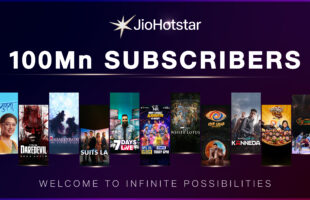
Tell me more about your OTT strategy.
Whatever we do, one of the ways we ensure our success is to be a reasonably early mover. As a 49-yearold company, we want to define the future of television. TVB has always been both a content producer and a platform operator, broadcasting digitally on terrestrial. Hence, we had to invest in the whole distribution network to get signals across to consumers. Primarily, we’re a content company, but today, you can’t seem to escape from collaborating the two in the digital world. The platforms are now beginning to get into the content business. It looks like dual play, both content and platform in a world ahead of us.
We’re trying to move all the television content on to an online delivery system, giving all the advantages to the consumer for better targeted choices that are relevant to the individual user. Meaning, there would be better picture quality, greater convenience to watch content linearly, on-demand, catch-up and more.
TVB has already gained 85% of free TV viewership in Hong Kong and a smaller share of the pay-TV business. That’s good for us in a way as we have less baggage. When you have a traditional pay-TV with a high ARPU, to move to a complete set of lower price point for a basic OTT model, there will be fear of cannibalisation. But we don’t have such fears as we have a very low base of subscribers.
What we’re trying to do in Hong Kong is to be an early mover in presenting the idea to consumers that one operator can offer you all the television content you need, whether it’s free or paid.
That’s what myTV SUPER is all about. The brand name is an extension of the free catch-up service of myTV that we launched in 2008 on mobile. We officially launched myTV SUPER on 18 April this year. One of the items we were looking for in the ecosystem was strong distribution and broadband partners which we found in Hong Kong Broadband Network (HKBN) and Hutchison Group. They’re both committed because their focus is on selling connectivity. They share the same vision with us, especially for the fixed home broadband.
A lot of bandwidth is being consumed by the internet; it triples or even quadruples when television is being watched via the internet. The development path of the internet and fibre technology is becoming more advanced, leading to decreasing cost per gigabyte and at the end of it; we are the early movers here.
Do you see any competition in Hong Kong itself?
As early movers, we see little competition because we have many parts of the pie. The whole ecosystem needs someone to aggregate the content. We on the other hand, have a library of free content collection because we have 85% of the free TV market. We have the ability to cumulate big chunks of Asian pay-TV content. Perhaps, we may need to strengthen in the Hollywood content segment. It’s more important to get the implementation right for the consumer, rather than worry about who’s trying to grab a bigger share for the same execution. It’s a very new concept, so the focus is on getting the deployment right, rather than worrying about “who’s going to compete with us”.
What are your USPs?
We have a few: On the television set, it’s delivering the quality and stability of the content on your TV set. We’re looking at HD content and potentially 4K for some consumers and the streaming stability that you would associate with traditional broadcast.
For product offering, there’s a line between the internet content world being limitless and the internet content world of quality curated content. If you want to be in the unlimited world, that is in the search engine business. We are not trying to be the Wikipedia of video content, with an enormous library. Searching via the TV set is not a very consumer-friendly exercise. We’re looking at quality curation with enough breadth and depth to satisfy 90% of our customers. That’s where the skills and execution comes from. You could feel very comfortable; going home to watch television and living off the box. You will feel that 80% of the time, you have got most of the content you ever need.
When do you think you’ll see some good numbers from subscription?
We are seeing great numbers in terms of take-up, but we still need to see greater numbers in terms of usage. These are pure subscribers as we’re pricing it very low. The challenge is to get good numbers in terms of takeup, usage and remain in the black rather than red. Our perception is that we could be in red for less than 5 years at the most. We think we’ll reach there, as most of the content is already being paid for. We will also try to work with more content partners. Of course, consumers will see more English content in the future. Here at APOS, we can connect with many who specialise in English content.
Whatever we do, one of the ways we ensure our success is to be a reasonably early mover. As a 49-yearold company, we want to define the future of television. TVB has always been both a content producer and a platform operator, broadcasting digitally on terrestrial. Hence, we had to invest in the whole distribution network to get signals across to consumers. Primarily, we’re a content company, but today, you can’t seem to escape from collaborating the two in the digital world. The platforms are now beginning to get into the content business. It looks like dual play, both content and platform in a world ahead of us.
We’re trying to move all the television content on to an online delivery system, giving all the advantages to the consumer for better targeted choices that are relevant to the individual user. Meaning, there would be better picture quality, greater convenience to watch content linearly, on-demand, catch-up and more.
TVB has already gained 85% of free TV viewership in Hong Kong and a smaller share of the pay-TV business. That’s good for us in a way as we have less baggage. When you have a traditional pay-TV with a high ARPU, to move to a complete set of lower price point for a basic OTT model, there will be fear of cannibalisation. But we don’t have such fears as we have a very low base of subscribers.
What we’re trying to do in Hong Kong is to be an early mover in presenting the idea to consumers that one operator can offer you all the television content you need, whether it’s free or paid.
That’s what myTV SUPER is all about. The brand name is an extension of the free catch-up service of myTV that we launched in 2008 on mobile. We officially launched myTV SUPER on 18 April this year. One of the items we were looking for in the ecosystem was strong distribution and broadband partners which we found in Hong Kong Broadband Network (HKBN) and Hutchison Group. They’re both committed because their focus is on selling connectivity. They share the same vision with us, especially for the fixed home broadband.
A lot of bandwidth is being consumed by the internet; it triples or even quadruples when television is being watched via the internet. The development path of the internet and fibre technology is becoming more advanced, leading to decreasing cost per gigabyte and at the end of it; we are the early movers here.
Do you see any competition in Hong Kong itself?
As early movers, we see little competition because we have many parts of the pie. The whole ecosystem needs someone to aggregate the content. We on the other hand, have a library of free content collection because we have 85% of the free TV market. We have the ability to cumulate big chunks of Asian pay-TV content. Perhaps, we may need to strengthen in the Hollywood content segment. It’s more important to get the implementation right for the consumer, rather than worry about who’s trying to grab a bigger share for the same execution. It’s a very new concept, so the focus is on getting the deployment right, rather than worrying about “who’s going to compete with us”.
What are your USPs?
We have a few: On the television set, it’s delivering the quality and stability of the content on your TV set. We’re looking at HD content and potentially 4K for some consumers and the streaming stability that you would associate with traditional broadcast.
For product offering, there’s a line between the internet content world being limitless and the internet content world of quality curated content. If you want to be in the unlimited world, that is in the search engine business. We are not trying to be the Wikipedia of video content, with an enormous library. Searching via the TV set is not a very consumer-friendly exercise. We’re looking at quality curation with enough breadth and depth to satisfy 90% of our customers. That’s where the skills and execution comes from. You could feel very comfortable; going home to watch television and living off the box. You will feel that 80% of the time, you have got most of the content you ever need.
When do you think you’ll see some good numbers from subscription?
We are seeing great numbers in terms of take-up, but we still need to see greater numbers in terms of usage. These are pure subscribers as we’re pricing it very low. The challenge is to get good numbers in terms of takeup, usage and remain in the black rather than red. Our perception is that we could be in red for less than 5 years at the most. We think we’ll reach there, as most of the content is already being paid for. We will also try to work with more content partners. Of course, consumers will see more English content in the future. Here at APOS, we can connect with many who specialise in English content.









